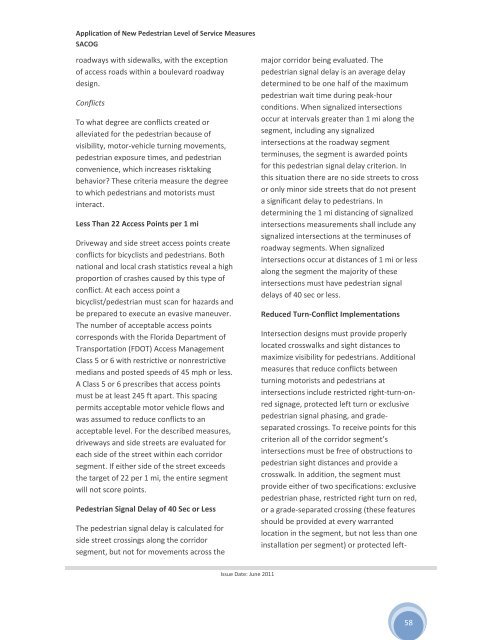Application of New Pedestrian Level of Service Measures - sacog
Application of New Pedestrian Level of Service Measures - sacog
Application of New Pedestrian Level of Service Measures - sacog
Create successful ePaper yourself
Turn your PDF publications into a flip-book with our unique Google optimized e-Paper software.
<strong>Application</strong> <strong>of</strong> <strong>New</strong> <strong>Pedestrian</strong> <strong>Level</strong> <strong>of</strong> <strong>Service</strong> <strong>Measures</strong><br />
SACOG<br />
roadways with sidewalks, with the exception<br />
<strong>of</strong> access roads within a boulevard roadway<br />
design.<br />
Conflicts<br />
To what degree are conflicts created or<br />
alleviated for the pedestrian because <strong>of</strong><br />
visibility, motor‐vehicle turning movements,<br />
pedestrian exposure times, and pedestrian<br />
convenience, which increases risktaking<br />
behavior? These criteria measure the degree<br />
to which pedestrians and motorists must<br />
interact.<br />
Less Than 22 Access Points per 1 mi<br />
Driveway and side street access points create<br />
conflicts for bicyclists and pedestrians. Both<br />
national and local crash statistics reveal a high<br />
proportion <strong>of</strong> crashes caused by this type <strong>of</strong><br />
conflict. At each access point a<br />
bicyclist/pedestrian must scan for hazards and<br />
be prepared to execute an evasive maneuver.<br />
The number <strong>of</strong> acceptable access points<br />
corresponds with the Florida Department <strong>of</strong><br />
Transportation (FDOT) Access Management<br />
Class 5 or 6 with restrictive or nonrestrictive<br />
medians and posted speeds <strong>of</strong> 45 mph or less.<br />
A Class 5 or 6 prescribes that access points<br />
must be at least 245 ft apart. This spacing<br />
permits acceptable motor vehicle flows and<br />
was assumed to reduce conflicts to an<br />
acceptable level. For the described measures,<br />
driveways and side streets are evaluated for<br />
each side <strong>of</strong> the street within each corridor<br />
segment. If either side <strong>of</strong> the street exceeds<br />
the target <strong>of</strong> 22 per 1 mi, the entire segment<br />
will not score points.<br />
<strong>Pedestrian</strong> Signal Delay <strong>of</strong> 40 Sec or Less<br />
The pedestrian signal delay is calculated for<br />
side street crossings along the corridor<br />
segment, but not for movements across the<br />
major corridor being evaluated. The<br />
pedestrian signal delay is an average delay<br />
determined to be one half <strong>of</strong> the maximum<br />
pedestrian wait time during peak‐hour<br />
conditions. When signalized intersections<br />
occur at intervals greater than 1 mi along the<br />
segment, including any signalized<br />
intersections at the roadway segment<br />
terminuses, the segment is awarded points<br />
for this pedestrian signal delay criterion. In<br />
this situation there are no side streets to cross<br />
or only minor side streets that do not present<br />
a significant delay to pedestrians. In<br />
determining the 1 mi distancing <strong>of</strong> signalized<br />
intersections measurements shall include any<br />
signalized intersections at the terminuses <strong>of</strong><br />
roadway segments. When signalized<br />
intersections occur at distances <strong>of</strong> 1 mi or less<br />
along the segment the majority <strong>of</strong> these<br />
intersections must have pedestrian signal<br />
delays <strong>of</strong> 40 sec or less.<br />
Reduced Turn‐Conflict Implementations<br />
Intersection designs must provide properly<br />
located crosswalks and sight distances to<br />
maximize visibility for pedestrians. Additional<br />
measures that reduce conflicts between<br />
turning motorists and pedestrians at<br />
intersections include restricted right‐turn‐onred<br />
signage, protected left turn or exclusive<br />
pedestrian signal phasing, and gradeseparated<br />
crossings. To receive points for this<br />
criterion all <strong>of</strong> the corridor segment’s<br />
intersections must be free <strong>of</strong> obstructions to<br />
pedestrian sight distances and provide a<br />
crosswalk. In addition, the segment must<br />
provide either <strong>of</strong> two specifications: exclusive<br />
pedestrian phase, restricted right turn on red,<br />
or a grade‐separated crossing (these features<br />
should be provided at every warranted<br />
location in the segment, but not less than one<br />
installation per segment) or protected left‐<br />
Issue Date: June 2011<br />
58
















